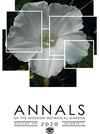新世界植物地理学:洪堡在大数据时代的相关性1
IF 1.3
3区 生物学
Q3 PLANT SCIENCES
引用次数: 7
摘要
摘要植物地理学试图描述物种分布的模式,并了解其潜在的机制。该领域的基础归功于亚历山大·冯·洪堡,他在两个世纪前探索新世界时获得了广泛的见解。如今,在“大数据”时代,方法和数据可用性的进步使我们能够更好地评估物种分布的复杂驱动因素。在这篇文章中,我们概述了洪堡在植物地理学领域的相关遗产。比较洪堡时代和今天最重要的见解和方法,我们强调了发生重大变化的领域和洪堡方法仍然相关的领域。我们在描述和理解植物地理学方面取得了进展,这使我们的整个世界观变得更加动态。此外,我们介绍了该领域的一些突出挑战,以及解决这些挑战需要回到“洪堡式”的科学方法,即将精确、定量的实证研究与整体方法相结合。最后,我们讨论了我们对人类世人类对地球影响的认识,这意味着我们的大部分研究不再完全由好奇心驱动,而是由预测生态系统对环境变化反应的社会需求驱动。因此,迫切需要将数量经验主义与整体视角相结合,以应对当前时代的复杂挑战。本文章由计算机程序翻译,如有差异,请以英文原文为准。
Geography of Plants in the New World: Humboldt's Relevance in the Age of Big Data 1
Abstract
Plant geography seeks to describe the patterns of species distributions and understand the underlying mechanisms. The foundation of the field is attributed to Alexander von Humboldt following the broad-scale insights he gained on his explorations of the New World two centuries ago. Today, in the age of “Big Data,” advances in methods and data availability allow us to better assess the complex drivers of species distributions. In this essay, we give an overview of the relevant legacy of Humboldt in the field of plant geography. Comparing the foremost insights and approaches of Humboldt's time and of today, we highlight areas in which major changes have taken place and areas in which Humboldt's approach is still relevant. We present advances in the description and understanding of plant geography, which have changed our entire worldview to a much more dynamic one. Further, we present some of the outstanding challenges of the field, and how solving them requires going back to the “Humboldtian” approach to science, i.e., combining precise, quantitative empirical studies with a holistic approach. Finally, we discuss how our recognition of the planetary impact of humans in the Anthropocene means that much of our research is no longer exclusively driven by curiosity, but also by the societal need to make predictions of ecosystem responses to environmental change. There is thus a strong need for combining quantitative empiricism with a holistic perspective to address the complex challenges of the current epoch.
求助全文
通过发布文献求助,成功后即可免费获取论文全文。
去求助
来源期刊
CiteScore
3.60
自引率
0.00%
发文量
15
期刊介绍:
The Annals of the Missouri Botanical Garden is a quarterly international journal primarily devoted to systematic botany and evolutionary biology. We encourage submissions of original papers dealing with significant advances in the taxonomy, phylogeny, biogeography, paleobiology, and evolution of plants, and in conservation genetics and biology, restoration ecology, and ethnobiology, using morphological and/or molecular characters, field observations, and/or database information. We also welcome reviews and papers on conceptual issues and new methodologies in systematics. Important floristic works will also be considered. Symposium proceedings discussing a broader range of topical biological subjects are also published, typically once a year. All manuscripts are peer-reviewed by qualified and independent reviewers.

 求助内容:
求助内容: 应助结果提醒方式:
应助结果提醒方式:


